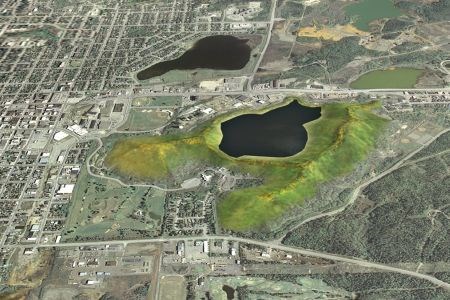The high price of gold is fuelling exploration in the Timmins area and ensuring the city's three gold mines remain in production.
“Last year was a great one,” said Brian Atkinson, regional resident geologist in Timmins. “The gold mines were operating at capacity and throughout the district, there are about 80 companies exploring for a variety of different metals and minerals, but gold is definitely the dominant focus because of the high price.”
Goldcorp operates two of the gold mines (Hoyle Pond and Dome Underground) and Lake Shore Gold's Timmins Mine came on stream last year.
“All are continuing to operate and Goldcorp is working on bringing the Hollinger Mine back into production, which was the largest gold mine in Canada,” he said.
In early January, the company announced it would begin development of the Hollinger open pit mine project, located adjacent to the dowtown core, with the construction phase lasting from 12 to 18 months at a cost of $75 million.
According to a press release, the initial focus will be on equipment procurement, installation of the dewatering system, site clearing and stripping, and the development of a five-kilometre haulage road between the Hollinger site and the Dome Mill. An overpass across a back road for trucks carrying ore to the mill will also be constructed.
Production is expected to begin in the second half of this year.
A berm will surround the property to reduce noise and dust, act as a safety barrier and provide people with an opportunity to walk along portions of it on a new trail system and view operations.
The project will remove hundreds of historical mine openings on the 250-acre property and Goldcorp will continue to employ more than 600 people and several hundred contractors for several years.
The company is also sinking a new shaft to access ores in deeper levels at its underground Hoyle Pond Mine.
“Those projects are big dollar expenditures, so it is looking good as far as Goldcorp goes,” Atkinson said.
At the west end of the city, Lake Shore Gold continues production at its Timmins Mine, with ore trucked to the Bell Creek Mill 42 kilometres away. The company has an underground exploration project at the Bell Creek Mine and at the Timmins Mine, there is a parallel zone it has been drilling.
“At the adjoining property, they drilled a really deep hole and they have encountered a west-plunging ore zone off the Timmins Mine at a depth of a 1.9 kilometre strike length,” Atkinson said.
“It's preliminary but suggests the mineralization is still going on so that has the possibility of being a long-term deposit.”
Lake Shore Gold's mining activities have stimulated a lot of additional exploration in the west end. Another junior company, Melkior Resources, is drilling north of the Timmins Mine.
“Traditionally, everyone thought that there was no gold west of the Mattagami fault and then Lake Shore came along and demonstrated otherwise,” Atkinson said.
Xstrata's Kidd Mine in Timmins completed an extension of its deep development, a project worth $120 million.
The world's deepest base metal mine is currently at 9,600 feet and will extend operations to at least the first half of 2018. Further extensions to the mine life have been identified through the 2020 Vision program to elicit suggestions from employees on how to maximize the value of the operation, according to a press release.
Launched in early 2011, the program has already resulted in cost savings and an additional 700,000 tonnes of ore reserves being identified to extend operations to 2020.
Development of Detour Gold's Detour Lake Mine continues to be a major employer in the area. The billion-dollar investment, in bringing the project into production early next year, involves about 1,000 people currently working at the site, located about 180 kilometres northeast of Cochrane.
De Beers' diamond Victor Mine, near Attawapiskat, continues to produce and uses Timmins as a base for its operations.
Liberty Mines is working on plans to restart production at its Timmins operations in the first quarter of this year. The nickel producer suspended mining due to maintenance and tailings pond related issues early last year.
The high gold price markets have helped junior exploration companies raise capital and helped to drive additional interest in the area.
“The 80 or so companies exploring in the area are not a record number but there has been a fair amount of capital available for them to explore,” Atkinson said.
Last year, about $800 million was spent on exploration in the province with the majority of it split between northeastern and northwestern Ontario.
“There is a great dollar value for exploration and people often forget the about the hidden numbers. In Timmins, exploration brings in millions of dollars,” Atkinson said.
While some juniors are finding new discoveries, most are looking at properties that have previously been explored.
“Anything that has a resource on it is being examined and drilled off to upgrade the resource and to see if it is viable to go to the next stage,” he said.




